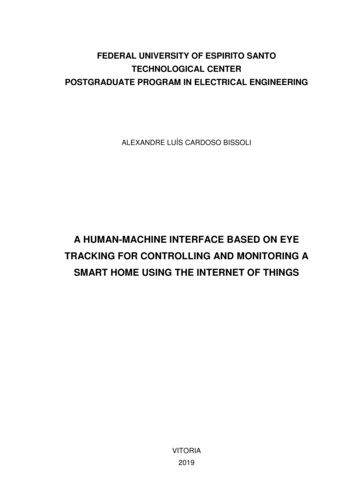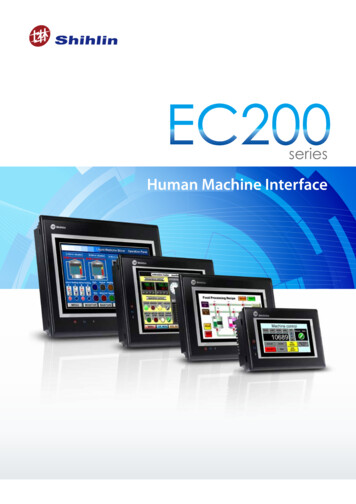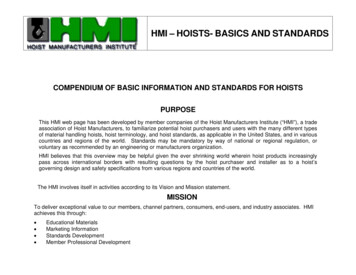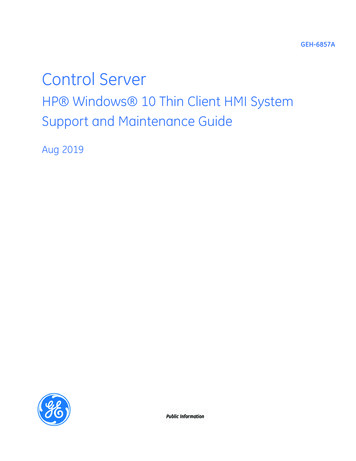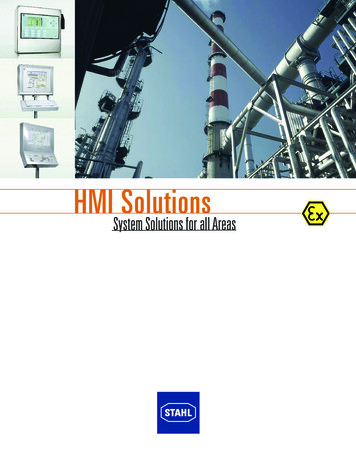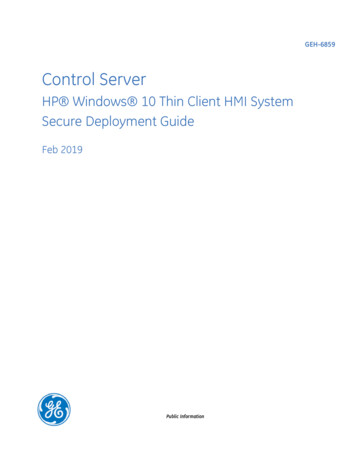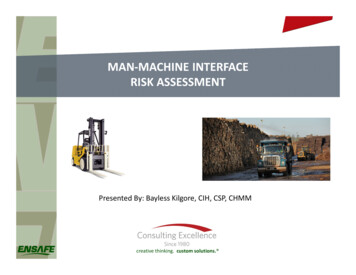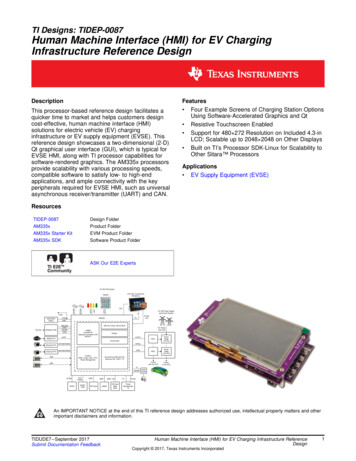
Transcription
TI Designs: TIDEP-0087Human Machine Interface (HMI) for EV ChargingInfrastructure Reference DesignDescriptionThis processor-based reference design facilitates aquicker time to market and helps customers designcost-effective, human machine interface (HMI)solutions for electric vehicle (EV) charginginfrastructure or EV supply equipment (EVSE). Thisreference design showcases a two-dimensional (2-D)Qt graphical user interface (GUI), which is typical forEVSE HMI, along with TI processor capabilities forsoftware-rendered graphics. The AM335x processorsprovide scalability with various processing speeds,compatible software to satisfy low- to high-endapplications, and ample connectivity with the keyperipherals required for EVSE HMI, such as universalasynchronous receiver/transmitter (UART) and CAN.Features Four Example Screens of Charging Station OptionsUsing Software-Accelerated Graphics and Qt Resistive Touchscreen Enabled Support for 480 272 Resolution on Included 4.3-inLCD; Scalable up to 2048 2048 on Other Displays Built on TI’s Processor SDK-Linux for Scalability toOther Sitara ProcessorsApplications EV Supply Equipment (EVSE)ResourcesTIDEP-0087AM335xAM335x Starter KitAM335x SDKDesign FolderProduct FolderEVM Product FolderSoftware Product FolderASK Our E2E ExpertsEV-SE HMI SystemLCD with Touchscreen(Resistive)AINGPIOLEDGPIO24 MHz32 KHzKeypadXDS100DVDebugWireless COMRS232 PHYJTAGEV-SE Power Stagesand Control System0JTAGI2CAM335x24-bitsLCDUSBSecurity Crypto, Secure BootMMC/SDUARTMcASPGPI0AC Powerfrom GridARM Cortex -A8Application processor owerStage(DC-DC)Commwith Car (EV)Powerto Car (EV)TouchscreenEthernet PHYEthernet PHYMII/RMII/RGMIIGPIOsCANsMII/RMII/RGMIISystemDMA, Timers, ADC, RTC,Power ManagementUSBConnectivity USB with Phy,Ethernet, SPI, UART, I2CUSBI2CAudioMcASPCodec32 BitsDDR38/16GPMCNAND /NORQSPIMMCSPI FlasheMMCMMC / SDSD CardMMCSDIOI 2CPowerPowerManagementICAn IMPORTANT NOTICE at the end of this TI reference design addresses authorized use, intellectual property matters and otherimportant disclaimers and information.TIDUDE7 – September 2017Submit Documentation FeedbackHuman Machine Interface (HMI) for EV Charging Infrastructure ReferenceDesignCopyright 2017, Texas Instruments Incorporated1
System Description1www.ti.comSystem DescriptionWith increasing battery capacity and decreasing battery cost, electric vehicles are becoming moremainstream each day. The EVSE is an infrastructure element that supplies electric energy for therecharging of electric vehicles, such as plug-in electric vehicles, including electric cars, neighborhoodelectric vehicles, and plug-in hybrids.The EVSE system consists of a power stage, some sort of central processing unit (CPU) such as amicrocontroller (MCU) or microprocessor (MPU), communication subsystems for both internal dataexchange and external communications, and an HMI.The Sitara AM335x processor, which is one of the most popular processors for industrial HMIapplications, not only has the resources targeted for processing the user interface of a charging station,but the AM335x processor’s easy-to-use programming tools and portfolio of on-chip capabilities givedesigners a head start on EVSE development projects.Based on the AM335x Starter Kit Evaluation Module (EVM), the TIDEP-0087 reference design is a quickstarting point for customers who want to design an EVSE HMI module or system for an EV charginginfrastructure.The TI AM335x high-performance processors are based on the ARM Cortex -A8 core (see Figure 1).These enhanced processors have rich peripherals and an advanced display capability, including 2-D and3-D acceleration to help customers design cost-effective EVSE HMIs. The devices support high-leveloperating systems (HLOS) such as Linux, which is available free of charge from TI. The devices offer anupgrade to systems based on lower-performance ARM cores, provide updated peripherals, and supportthe typical interfaces to connect to EV charging power stages, such as UART and CAN.Figure 1. Sitara AM335x ChipThe AM335x supports 24-bit, liquid-crystal display (LCD) controllers with a resolution up to 2048 2048,which allows system designers to select various screen sizes and resolutions based on use cases andprovides scalability from low to mid-end.The Qt framework is used to develop the GUI for EVSE HMI application software. Qt is a cross-platformapplication framework written in C . Learn more about Qt at https://www.qt.io.2Human Machine Interface (HMI) for EV Charging Infrastructure ReferenceDesignCopyright 2017, Texas Instruments IncorporatedTIDUDE7 – September 2017Submit Documentation Feedback
System Overviewwww.ti.com2System Overview2.1Block DiagramEV-SE HMI SystemLCD with Touchscreen(Resistive)AINGPIOLEDGPIO32 KHz24 MHzKeypadXDS100DVDebugWireless COMRS232 PHYJTAGEV-SE Power Stagesand Control System0JTAGI2CAM335x24-bitsLCDUSBSecurity Crypto, Secure BootMMC/SDUARTMcASPGPI0AC Powerfrom GridARM Cortex -A8Application processor owerStage(DC-DC)Commwith Car (EV)Powerto Car (EV)TouchscreenEthernet PHYEthernet PHYMII/RMII/RGMIIGPIOsMII/RMII/RGMIICANsSystemDMA, Timers, ADC, RTC,Power ManagementUSBConnectivity USB with Phy,Ethernet, SPI, UART, I2CUSBI2CMcASP32 BitsDDR38/16GPMCNAND /NORQSPISPI FlashMMCeMMCMMC / SDSD CardMMCSDIOI 2CAudioCodecPowerPowerManagementICFigure 2. EVSE HMI Block DiagramTIDUDE7 – September 2017Submit Documentation FeedbackHuman Machine Interface (HMI) for EV Charging Infrastructure ReferenceDesignCopyright 2017, Texas Instruments Incorporated3
System Overview2.22.2.1www.ti.comHighlighted ProductsAM335xThe AM335x processors, based on the ARM Cortex-A8 core, are enhanced with image, graphicsprocessing, peripherals, and industrial interface options, such as EtherCAT and PROFIBUS .These devices support HLOS, such as Linux. The AM335x processors contain the subsystems inFigure 3: the microprocessor unit (MPU) subsystem, which is based on the ARM Cortex-A8 core, and thePowerVR SGX , which is a graphics accelerator subsystem that provides 3-D graphics acceleration tosupport display and gaming effects.The Programmable Real-Time Unit Subsystem and Industrial Communication SubSystem (PRU-ICSS) isseparate from the ARM core and allows independent operation and clocking for greater efficiency andflexibility. The PRU-ICSS enables additional peripheral interfaces and real-time protocols, such asEtherCAT, PROFINET , EtherNet/IP , PROFIBUS, Ethernet Powerlink , Sercos , and others.ARM Cortex A8Up to 1 GHz*PRU -ICSSGraphics AccelerationPacSGX530Industrial CommunicationSubsystem32 K / 32 K L1256 K L2 w/ ECCEtherCAT PROFINET EtherNET/IPΠ, andmoreLCD Controller64 K RAM24bit LCD Cont.64 KB L3 Shared RAMTouch Screen Controller(1)Security AccelerationPacCryptoLPDDR1 / DDR2/ DDR3 /DDR3LSystem ServicesEDMAJTAG / ETBTimers x8WDTRTC12-bit ADC(1)Connectivity and IOsEMAC 2-portw/ Switch 10 /100 / 1 G w/1588USB2 OTG PHYx2CAN x2eCAP / eQEPx3PWM x3McASP x2SPI x2GPIOI2C x3UART x6NAND / NOR(16bit ECC)MMC / SD/ SDIOx300 MHz / 1 GHz only available on 15 x 15 package. 13 x 13 support up to 600 MHz. Use of TSC will limit available ADCchannels.Copyright 2017, Texas Instruments IncorporatedFigure 3. AM335x Block DiagramAdditionally, the programmable nature of the PRU-ICSS, along with its access to pins, events, and allsystem-on-chip (SoC) resources, provides flexibility in implementing fast, real-time responses, specializeddata handling operations, custom peripheral interfaces, and in offloading tasks from the other processorcores of an SoC.4Human Machine Interface (HMI) for EV Charging Infrastructure ReferenceDesignCopyright 2017, Texas Instruments IncorporatedTIDUDE7 РSeptember 2017Submit Documentation Feedback
Hardware, Software, Testing Requirements, and Test Resultswww.ti.com3Hardware, Software, Testing Requirements, and Test Results3.1Required Hardware and Software3.1.1HardwareThe AM335x Starter Kit EVM is required to run the EVSE HMI demonstration application. The AM335xStarter EVM is a stand-alone test, development, and evaluation module system that enables developers towrite software and develop hardware around an AM335x processor subsystem.See the AM335x Starter Kit Hardware User's Guide for instructions on getting started and details on thehardware architecture of the AM335x Starter Kit EVM.3.1.2SoftwareThe AM335x Processor SDK for Linux (Processor-SDK-Linux) provides a fundamental software platformfor development, deployment, and execution of Linux-based applications. The EVSE HMI demonstrationapplication source code is integrated in the Processor-SDK-Linux. The example application can be playedthrough Matrix GUI application launcher. More information on Qt application development usingProcessor-SDK-Linux can be found in and .The Processor-SDK-Linux package contains a software user's guide and additional documentation forsetting up and running the demonstration applications. Download the package fromwww.ti.com/tool/PROCESSOR-SDK-AM335X.For the purposes of this design guide, use a Linux host machine for the following instructions. With therequired hardware, program the SD card with the Linux processor SDK image using the following steps:1. Download the SDK installer Install.bin from TI.com(where xx.xx.xx.xx is the version number of the latest Linux processor SDK).2. Create the SD card with default images using the SDK Create SD Card Script or see the user's guide.3. Boot the Linux kernel and file system using the created SD card.3.23.2.1Testing and ResultsTest SetupThis subsection provides details of the test setup with the required hardware and software to run the TIEVSE HMI software application.1. Insert the micro SD card created in Section 3.1.2 in the location shown in Figure 4.2. Insert the 5-V power supply and press the power button shown in Figure 4.Figure 4. AM335x Starter Kit Setup (LCD Face Down)TIDUDE7 – September 2017Submit Documentation FeedbackHuman Machine Interface (HMI) for EV Charging Infrastructure ReferenceDesignCopyright 2017, Texas Instruments Incorporated5
Hardware, Software, Testing Requirements, and Test Resultswww.ti.com3. The board boots up, the Matrix GUI application launches, and the interface shows on the LCD screen(see Figure 5).Figure 5. AM335x Starter Kit Setup (LCD Face Up)3.2.2Test ResultsThe test results are as follows:1. Figure 6 shows the default Matrix GUI. Click on the HMI icon to navigate to the EVSE HMIdemonstration.Figure 6. AM335x Default Matrix GUI6Human Machine Interface (HMI) for EV Charging Infrastructure ReferenceDesignCopyright 2017, Texas Instruments IncorporatedTIDUDE7 – September 2017Submit Documentation Feedback
www.ti.comHardware, Software, Testing Requirements, and Test Results2. Figure 7 shows the HMI Submenu, which is the next screen that appears. Click on the EVSE icon.Figure 7. HMI Submenu3. Figure 8 then shows on the screen. Click the Run button to launch the EVSE HMI demonstration GUI.Figure 8. EVSE HMI Description and Run ScreenTIDUDE7 – September 2017Submit Documentation FeedbackHuman Machine Interface (HMI) for EV Charging Infrastructure ReferenceDesignCopyright 2017, Texas Instruments Incorporated7
Hardware, Software, Testing Requirements, and Test Resultswww.ti.com4. The EVSE HMI demonstration GUI launches and the Welcome screen shows (see Figure 9). The green Click to Continue button on the left navigates to the next page of the demonstration. The orange Exit button on the right exits out of the demonstration and returns to the Matrix GUI inthe previous Figure 6.NOTE: The Exit button on this screen is the only way to exit out of the demonstration GUI andreturn to the Matrix GUI.Figure 9. EVSE HMI Demonstration GUI—Welcome Screen (Page One)5. The Click to Continue button in Figure 9 leads to the charging mode screen shown in Figure 10. All four of the option buttons (Option 1 through Option 4) direct the user to the third page of theGUI. The home icon in the bottom-right corner directs the user back to the Welcome screen in Figure 9.Figure 10. EVSE HMI Demonstration GUI—Charging Mode Screen (Page Two)8Human Machine Interface (HMI) for EV Charging Infrastructure ReferenceDesignCopyright 2017, Texas Instruments IncorporatedTIDUDE7 – September 2017Submit Documentation Feedback
Hardware, Software, Testing Requirements, and Test Resultswww.ti.com6. Figure 11 shows page three of the GUI. The Ok button directs the user to the last page of the GUI. The home icon in the bottom-right corner leads to the Welcome screen in Figure 9.Figure 11. EVSE HMI Demonstration GUI—Rate Period Setting Screen (Page Three)7. Figure 12 shows the last page in the demonstration. After pressing the Begin Charge button, the progress bar, Remaining Time field, and Elapsed Timefield begin updating. The End Charge button directs the user back to the Welcome screen in Figure 9.Figure 12. EVSE HMI Demonstration GUI—Rate-Charging Metrics Screen (Page Four)TIDUDE7 – September 2017Submit Documentation FeedbackHuman Machine Interface (HMI) for EV Charging Infrastructure ReferenceDesignCopyright 2017, Texas Instruments Incorporated9
Design Files4www.ti.comDesign FilesTo download the hardware design files for the AM335x Starter Kit, see the design files at TIDEP-0087.5Software FilesDownload the Processor SDK Linux for AM335x from the AM335x software product page.6Related Documentation1. Texas Instruments, AM335x Starter Kit Hardware User's Guide, AM335x Wiki Page2. Texas Instruments, Qt Training: Multipage Resizable Graphical User Interfaces containing Media,Application Report (SPRACB2)3. Texas Instruments, Sitara Linux Training: Hands on with QT, Wiki Page4. Texas Instruments, Processor SDK Linux Software Developer's Guide, Wiki Page5. Texas Instruments, Processor Linux SDK Graphics and Display, Wiki Page6.1TrademarksSitara is a trademark of Texas Instruments.EtherCAT is a registered trademark of Beckhoff Automation GmbH, Germany.Ethernet Powerlink is a trademark of Bernecker Rainer Industrie-ElektronikGes.m.b.H.PowerVR SGX is a trademark of Imagination Technologies Limited.EtherNet/IP is a trademark of Odva, Inc.PROFIBUS, PROFINET are registered trademarks of PROFIBUS and PROFINET International (PI).Sercos is a trademark of Sercos International.All other trademarks are the property of their respective owners.7TerminologyEV— Electric vehicleEVM— Evaluation moduleEVSE— Electric vehicle supply equipmentGUI— Graphical user interfaceHLOS— High-level operating systemsHMI— Human machine interfacePRU-ICSS— Programmable Real-Time Unit Subsystem and Industrial Communication SubSystemSDK— Software development kitSoC— System-on-chipUART— Universal asynchronous transmitter/receiver8About the AuthorAMRIT MUNDRA is a part of System Team in Catalog Processors BU. He has been with TI for more than14 years and has worked on multiple IPs and SoCs. He is the security architect for Keystone3 andsecurity lead for Catalog BU. Amrit also is System lead for EPOS EE initiative in BU. Amrit earned hisMaster of Science in Electrical Engineering (MSEE) from SMU, Dallas, TX.MANISHA AGRAWAL is part of Software Application team in the Catalog Processors BU. She has beenwith TI for more than 11 years and has worked on OMAP, DAVINCI and Sitara platforms. She is theApplication lead for all the applications that includes video IPs such as capture, display, graphics, codec,and other video processing engine on these devices. Manisha earned her Master of Science in DigitalSignal Processing from IIT, Kanpur, India.10Human Machine Interface (HMI) for EV Charging Infrastructure ReferenceDesignCopyright 2017, Texas Instruments IncorporatedTIDUDE7 – September 2017Submit Documentation Feedback
IMPORTANT NOTICE FOR TI DESIGN INFORMATION AND RESOURCESTexas Instruments Incorporated (‘TI”) technical, application or other design advice, services or information, including, but not limited to,reference designs and materials relating to evaluation modules, (collectively, “TI Resources”) are intended to assist designers who aredeveloping applications that incorporate TI products; by downloading, accessing or using any particular TI Resource in any way, you(individually or, if you are acting on behalf of a company, your company) agree to use it solely for this purpose and subject to the terms ofthis Notice.TI’s provision of TI Resources does not expand or otherwise alter TI’s applicable published warranties or warranty disclaimers for TIproducts, and no additional obligations or liabilities arise from TI providing such TI Resources. TI reserves the right to make corrections,enhancements, improvements and other changes to its TI Resources.You understand and agree that you remain responsible for using your independent analysis, evaluation and judgment in designing yourapplications and that you have full and exclusive responsibility to assure the safety of your applications and compliance of your applications(and of all TI products used in or for your applications) with all applicable regulations, laws and other applicable requirements. Yourepresent that, with respect to your applications, you have all the necessary expertise to create and implement safeguards that (1)anticipate dangerous consequences of failures, (2) monitor failures and their consequences, and (3) lessen the likelihood of failures thatmight cause harm and take appropriate actions. You agree that prior to using or distributing any applications that include TI products, youwill thoroughly test such applications and the functionality of such TI products as used in such applications. TI has not conducted anytesting other than that specifically described in the published documentation for a particular TI Resource.You are authorized to use, copy and modify any individual TI Resource only in connection with the development of applications that includethe TI product(s) identified in such TI Resource. NO OTHER LICENSE, EXPRESS OR IMPLIED, BY ESTOPPEL OR OTHERWISE TOANY OTHER TI INTELLECTUAL PROPERTY RIGHT, AND NO LICENSE TO ANY TECHNOLOGY OR INTELLECTUAL PROPERTYRIGHT OF TI OR ANY THIRD PARTY IS GRANTED HEREIN, including but not limited to any patent right, copyright, mask work right, orother intellectual property right relating to any combination, machine, or process in which TI products or services are used. Informationregarding or referencing third-party products or services does not constitute a license to use such products or services, or a warranty orendorsement thereof. Use of TI Resources may require a license from a third party under the patents or other intellectual property of thethird party, or a license from TI under the patents or other intellectual property of TI.TI RESOURCES ARE PROVIDED “AS IS” AND WITH ALL FAULTS. TI DISCLAIMS ALL OTHER WARRANTIES ORREPRESENTATIONS, EXPRESS OR IMPLIED, REGARDING TI RESOURCES OR USE THEREOF, INCLUDING BUT NOT LIMITED TOACCURACY OR COMPLETENESS, TITLE, ANY EPIDEMIC FAILURE WARRANTY AND ANY IMPLIED WARRANTIES OFMERCHANTABILITY, FITNESS FOR A PARTICULAR PURPOSE, AND NON-INFRINGEMENT OF ANY THIRD PARTY INTELLECTUALPROPERTY RIGHTS.TI SHALL NOT BE LIABLE FOR AND SHALL NOT DEFEND OR INDEMNIFY YOU AGAINST ANY CLAIM, INCLUDING BUT NOTLIMITED TO ANY INFRINGEMENT CLAIM THAT RELATES TO OR IS BASED ON ANY COMBINATION OF PRODUCTS EVEN IFDESCRIBED IN TI RESOURCES OR OTHERWISE. IN NO EVENT SHALL TI BE LIABLE FOR ANY ACTUAL, DIRECT, SPECIAL,COLLATERAL, INDIRECT, PUNITIVE, INCIDENTAL, CONSEQUENTIAL OR EXEMPLARY DAMAGES IN CONNECTION WITH ORARISING OUT OF TI RESOURCES OR USE THEREOF, AND REGARDLESS OF WHETHER TI HAS BEEN ADVISED OF THEPOSSIBILITY OF SUCH DAMAGES.You agree to fully indemnify TI and its representatives against any damages, costs, losses, and/or liabilities arising out of your noncompliance with the terms and provisions of this Notice.This Notice applies to TI Resources. Ad
software-rendered graphics. The AM335x processors provide scalability with various processing speeds, compatible software to satisfy low- to high-end applications, and ample connectivity with the key peripherals required for EVSE HMI, such as universal asynchronous receiver/transmitter (UAR
